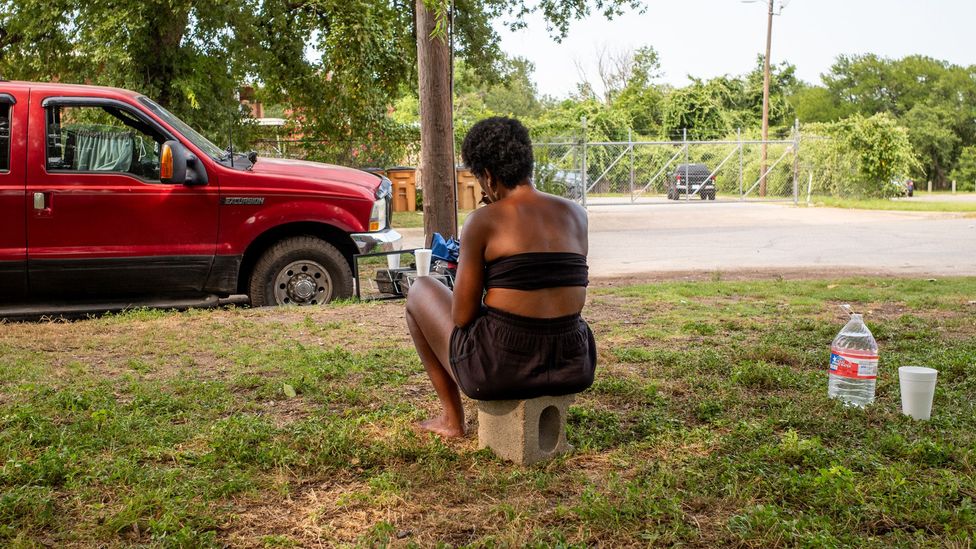This summer, Texans have endured scorching temperatures as hot as 48C (119F), making the state one of the hottest places on Earth.
The state is trapped under a "heat dome", a phenomenon that happens when high pressure traps dry, hot air over an area, causing the hot air to sink to the earth's surface and preventing clouds from forming. Due to high humidity, these temperatures feel even hotter. And forecasters project the intense heat will expand north into the Plains and from the west coast to the Gulf Coast in the coming days, leaving millions more people facing excessive heat warnings.
But as the heatwave continues, many cities in Texas are beginning to take proactive measures to cool their streets down and protect people from the dangerous impacts of overheating. These cooling measures are also being implemented more widely across the US, from installing green roofs and walls and painting streets with cool pavement coating to purchasing air conditioning units for vulnerable residents.
"Planning for heat is not as well-developed in the US as planning for other hazards like flooding," says Sara Meerow, associate professor at Arizona State University's school of geographical sciences and urban planning. "I think this is changing as heat becomes a more visible and universal threat."
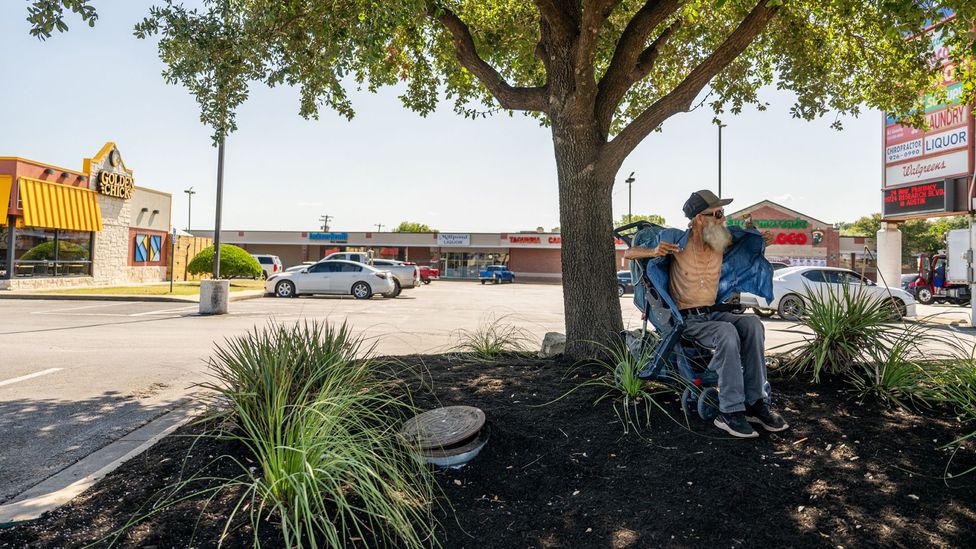
Homeless resident Randy Twede, waits for a bus in July 2023 in Austin, Texas. 'These temperatures are no joke, I'm just trying to survive that's all.' (Credit: Getty Images)
A particularly concerning aspect of this year's heatwave is that temperatures are not cooling down enough at night, leading to "more danger than a typical heat event", according to the National Weather Service.
The number of record high temperatures measured across Texas has increased 510% since 1913, with at least 279 people dying of heat-related illness last year, according to Texas Tribune analysis. (Read more about whether Texas could become too hot for humans).
Researchers have already linked the heatwave, which stretches across Texas, the US Southwest and Mexico, to climate change, with a rapid analysis finding climate change made it at least five times more likely as it would otherwise have been.
Heatwaves are particularly dangerous for city-dwellers due to a phenomenon known as the "urban heat island" effect. A lack of trees, the density of buildings, and concrete and asphalt materials that soak up the sun's rays means cities sequester heat. In these urban heat islands temperatures can be up to 20F (~6-11C) hotter than less populated areas.
But cities can take measures to protect their residents against the heat – and many in Texas are already beginning to take action.
You might also like:
- How ancient 'skywells' are keeping Chinese homes cool
- The simple ways cities can adapt to heatwaves
- The white roofs cooling women's homes in Indian slums
Austin, which is expecting a 50% increase of days above 38C (100F) by the end of the century – roughly 45 days of extreme heat every year – laid out a climate resilience action plan in 2018, which city officials are currently updating. Key strategies in the plan include strengthening emergency response and future-proofing new facilities and infrastructure.
The city set out a coordinated approach to provide cooling relief to vulnerable populations at times of crisis, including an inventory of backup fans which the public could access during emergencies, and a push to ensure people could access community facilities with air conditioning. It also developed an urban forest canopy for the city to ensure cool outdoor spaces. The city has now applied for a United States Department of Agriculture (USDA) grant to plant more trees after finding the tree canopy coverage was helping Austin to adapt to hotter temperatures.
In addition to physical adaptations we have found that increasing social connectivity helps increase community resilience to extreme heat – Laura Patiño
However, the city also found that more work needed to be done to tackle inequalities, particularly for communities of colour and low income. Research has shown significant disparities between the temperatures encountered by black and white urban residents across the US, with one study finding black people are exposed to air 0.28C warmer than the city average, while white residents experience temperatures 0.22C cooler. People living in historically redlined neighbourhoods – where racial discrimination influenced loan approvals in the past – face higher levels of outdoor heat stress compared to their counterparts in non-redlined areas of the city, the study found.
Austin officials are now developing a new resilience plan with a focus on heat mitigation, including researching new ways to combat heat and securing funding to tackle disparities between communities.
"In addition to physical adaptations we have found that increasing social connectivity helps increase community resilience to extreme heat," says Laura Patiño, the city's chief resiliency officer. "The city has established six resilience hubs to meet the daily climate stressors of city residents while building long-standing community assets and systems of support."
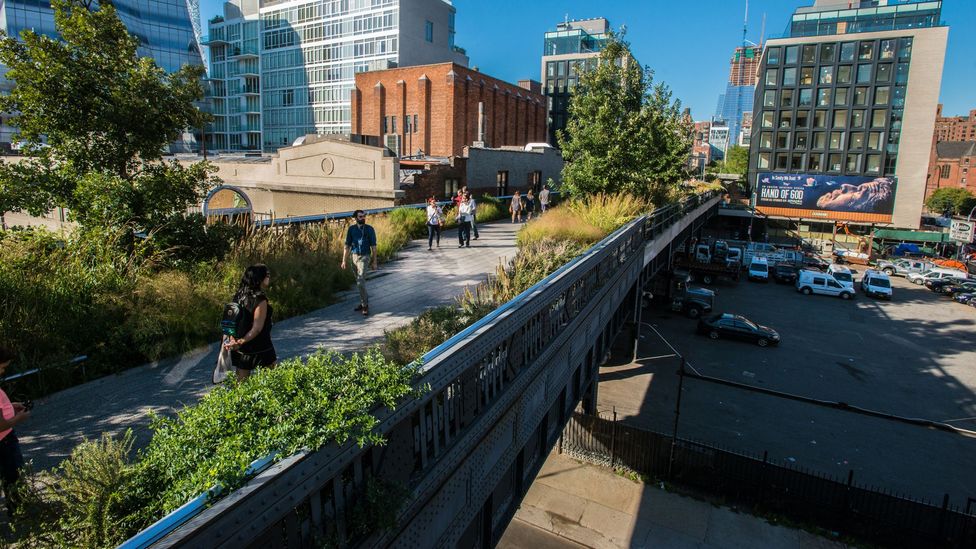
The New York highline is one of several urban canopies around the US which have been found to provide cooling on hot days (Credit: US Dep Agriculture USDA)
Some hubs offer bathrooms, mobile phone charging and shaded community spaces, while others can provide emergency food and water, as well as temporary shelter. The locations for the hubs were selected using a social vulnerability index to ensure they are in areas where residents most need assistance. Officials are working with community partners to build trust and relationships with locals to encourage use of the hubs. By 2025, Austin plans to grow the network to 30 hubs across the city.
Austin is also working with community organisers to map out the city's hottest areas, drive community engagement, and propose solutions for heat management, Patiño adds. "We know that heat has environmental and infrastructure consequences: reducing water availability, contributing to poor air quality, impacting our roads, increasing our energy use, and putting stress on our electricity grid," she says. "But heat also causes the most detrimental health impacts of all climate disasters – and is severely affecting the health of all Austinites, especially for outdoor workers and children."
Addressing systemic inequities and barriers are also a priority for the city in its approach to heat, she adds. Planting trees, for example, may seem like a simple solution, but they can be hugely effective, particularly in states like Texas, where historically redlined communities have as much as 21% less tree cover than neighbourhoods that haven't faced racial discrimination. (Read about how climate change divides along racial lines in our story about racial climate justice).
A report by the Texas Trees Foundation, a non-profit working to increase urban tree canopies across the state, found trees cooled some areas as much as 15F (~8C) on hot days. Shaded surfaces can be 20-45F cooler (~11-24C) than peak temperatures in unshaded areas. Beyond just providing shade, the trees help to cool the air, as water evaporates from their leaves. The report found that in Dallas, planting trees was three times more effective than other cooling strategies.
Since 1982, the foundation has planted an estimated 1.5 million trees in public streets, boulevards, schools and parks across North Texas. The foundation estimates their future tree planting will sequester an enormous 3.2 trillion pounds (1.45 billion tonnes) of carbon over the course of the next 50 years, as well as creating 2.2 trillion sq ft (204 billion sq m) of additional tree canopy.
"Trees have been shown to be vital for reducing heat stress and decreasing the size and effect of the urban heat island," says Rachel McGregor, urban forestry manager for the foundation. "Critical infrastructure in low-income neighbourhoods often lack trees to mitigate the urban heat island effect, poor air quality, climate change, crime rates, and a myriad of other challenges that they face but lack the resources to address."
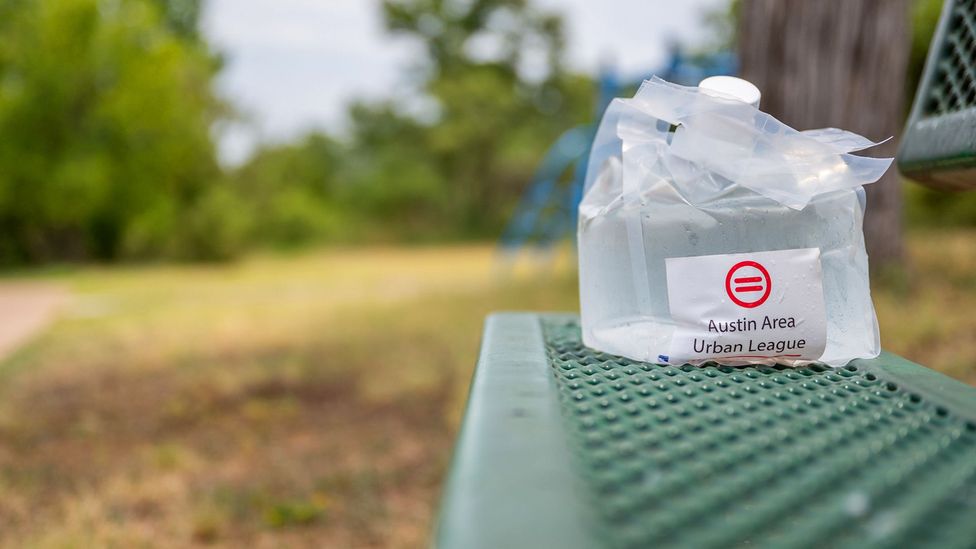
The Austin Area Urban League is one of several organisations which aims to support access to clean water during heatwaves (Credit: Getty Images)
Meanwhile, in 2021, San Antonio became the first city in Texas to participate in a pilot project to lower pavement temperatures by applying a coat of paint that reflects the sun's rays. The city earmarked a handful of streets to apply the cool pavement seal. While it is too early to determine if the project has led to lowering the air temperature, early analysis showed a 10-15F (~6-8C) difference in road surface temperature, says Nicholas Olivier, a spokesman for the City of San Antonio.
"Heat resilience is of great importance," says Olivier. "After last year's record-breaking summer, the city accelerated the implementation of its heat mitigation tools – such as cool roofs, tree canopy and cool pavement – with a few strategic moves."
The whitest roofs
A team of scientists have designed the "whitest paint ever" which reflects up to 98% of sunlight – compared to commercial white paints that reflect between 80 to 90% of light. The Purdue ultrawhite paint is designed to coat rooftops, cooling the building underneath by as much as 40%.
San Antonio established a climate action fund last year, committing a minimum of $8m (£6.2m) a year for the next five years, which has announced funding for a further 10 cool pavement pilot projects across the city. The city will study the locations with the new coating for a further six months, working with the University of Texas to evaluate the paint's potential to cool the city down. A second phase of pilot projects is set to combine cool roofs, trees, cool pavements and other heat relief efforts in the most vulnerable neighbourhoods.
Beyond Texas, numerous other US cities are adopting strategies to cope with the heat. Las Vegas is planting 60,000 trees by 2050. However, it is facing problems as its current tree canopy struggles to deal with the heat. It is now working with a nursery to find species, such as eucalyptus, acacia, and mesquite, that can adapt to drought and extreme temperatures.
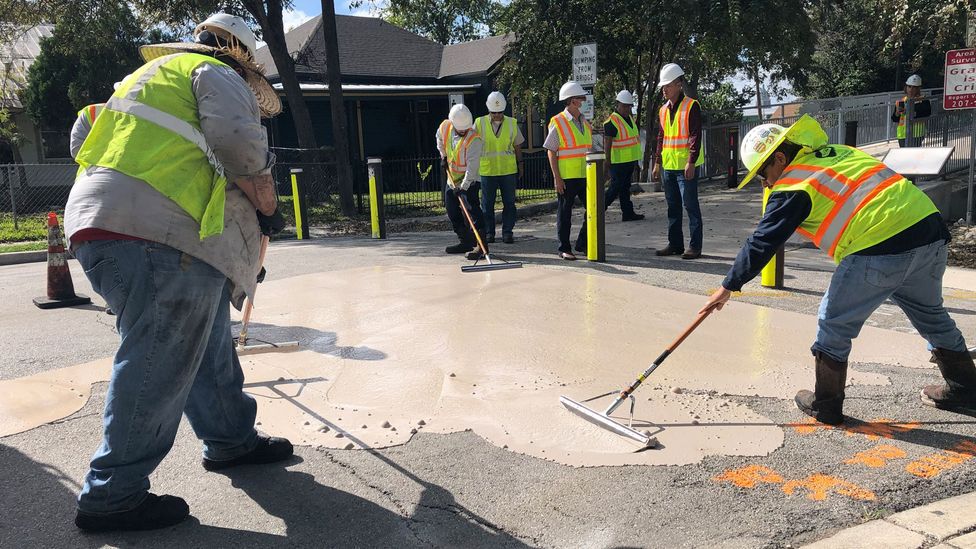
A pavement is painted white to reflect the heat in San Antonio in April 2023 (Credit: City of San Antonio)
New York City is promoting a "Be-a-Buddy" programme to share information with vulnerable populations about how to stay cool during heatwaves, as well as increasing the city's use of cooling centres. The city's Cool Roofs programme trains local volunteers to work with city teams to coat rooftops with a white reflective coating. So far, more than 9.2 million sq ft (850,000 sq m) of rooftops have been coated. Cool rooftops reduced internal building temperatures by up to 30% as well as helping lower the city's temperature – black asphalt rooftops can reach temperatures of up to 190F (88C) in the summer.
In Chicago, a text and email emergency notification system identifies public places, like libraries, as destinations with air conditioning. It also has a new call number for vulnerable populations who need assistance to get to these centres. The city also established a new fund to finance commercial green roofs and increase vegetation in heat island areas. Following a study that showed green spaces lowered land surface temperatures, Chicago is investing $46m (£35m) to plant 75,000 trees by 2026, envisioning the programme will reduce urban heat islands and pollution burdens.
Without more state and federal support, I worry that larger and better resourced communities will advance their heat planning, while other communities are left behind – Sara Meerow
At a federal level, the US Environmental Protection Agency has developed best practices for cooling down cities to encourage the adoption of heat mitigating policies. Promoting parks and open space in developed areas is identified as a key cooling strategy, as well as constructing pavements, streets and parking lots with permeable paving materials – and incorporating green and cool roofs into building designs.
Carbon Count
The emissions from travel it took to report this story were 0kg CO2. The digital emissions from this story are an estimated 1.2g to 3.6g CO2 per page view. Find out more about how we calculated this figure here.
"At this point all cities need to be planning for extreme heat," says Meerow. "This includes cities where heat has not traditionally been an issue."
More state and federal support for heat planning would be beneficial, says Meerow, who calls for more regulations and increased funding for communities. She would also like to see the federal government declaring heat events as "disasters" – as is already the case with hurricanes and floods.
"We are already seeing more cities investing in efforts to both mitigate and manage heat," she says. "The challenge is that heat is just one of the urgent issues cities need to plan for with limited resources.
"Without more state and federal support, I worry that larger and better resourced communities will advance their heat planning, while other communities are left behind."
--
Join one million Future fans by liking us on Facebook, or follow us on Twitter or Instagram.
If you liked this story, sign up for the weekly bbc.com features newsletter, called "The Essential List" – a handpicked selection of stories from BBC Future, Culture, Worklife, Travel and Reel delivered to your inbox every Friday.
